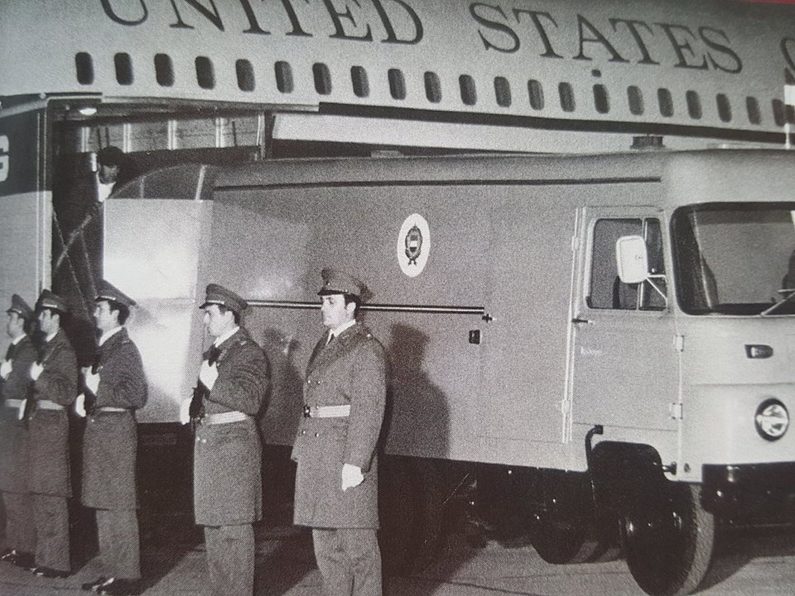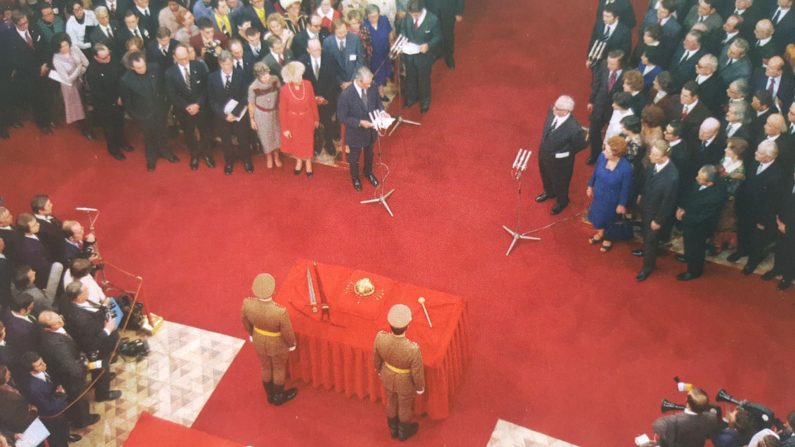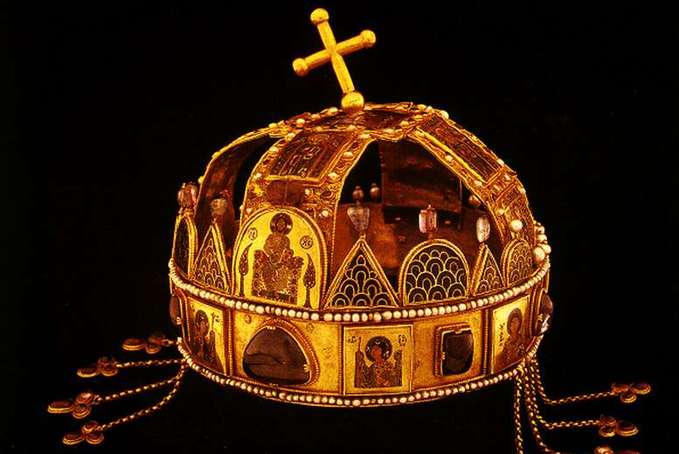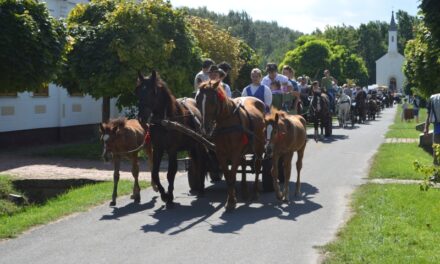The White House's response to the cardinal's letter dated October 13, 1970, now written to President Robert Milhouse Nixon, arrived only months later, in January 1971.
The ambassador verbally communicated the four-point position regarding the Holy Crown to the cardinal: his letter was received by the White House, where it was studied, and their message is that;
There are currently no plans to return the Holy Crown to Hungary; they appreciate the Cardinal's interest in the matter; in the end, they regret that they cannot comply with his request and send the Holy Crown to the Vatican, because it is clearly the property of the Hungarian nation, and under the circumstances they cannot unilaterally transfer the Hungarian treasure from their safekeeping to a third party.
Following the agreement signed by the Holy See and the Government of the Hungarian People's Republic on September 9, the cardinal was able to leave his Szabadság tér shelter on September 28, 1971, and arrived at the Vatican in the early afternoon of the same day. Let's not forget that the years of captivity were bloody and trying decades for the people of the country, but apparently with the aim of exerting pressure, on December 28, 1962, the General Prosecutor's Office ordered an investigation against the Cardinal, who enjoyed the asylum of the embassy, for the crime of treason and leading an organization aimed at overthrowing the state order. .
Cardinal Mindszenty was already living in Vienna when he persuaded the President of the United States twice in 1972 not to return the Holy Crown to Hungary. to Nixon on October 26 . In it, he also put on paper - repeatedly establishing his decades-old position - that the national relics can be handed over to the Vatican.
The answer may have saddened him, because his idea - in accordance with the similarly consistent position in Washington - was again not supported, because the Vatican was not called to guard the Holy Crown, but "it must return to the Hungarian nation". Although the Hungarian emigration wanted him to, in May 1974, during his visit to the United States of America, the cardinal was not allowed to meet the president, nor could he raise a word with him personally so that the Holy Crown would not be returned to the Hungary ruled by Kádár .
On December 18, 1973, Pope Pál The vacancy of the archbishopric of Esztergom was announced on February 5, 1974 in the Vatican. On April 3, 1974, the cardinal wrote a signed but not sent "letter of appeal" VI. to Pope Paul. It reads that "what has happened so far in relation to Esztergom practically makes it easier for President Nixon to get the Holy Crown into ungodly hands. Until now, the president has continuously confirmed to me that he continues to grant him sacred [appropriate] protection, but later he made statements in the mass media that fill me with unease. [...]" "All of this stemmed from the cardinal's understanding of the constitutional role, his loyalty and attachment to the ancient St. István constitution and the Holy Crown," states Tibor Zinner .
The United States of America after Helsinki, James Earl "Jimmy" Carter jr . during his presidency, on January 5, 1978, he returned the coronation jewels to Hungary. The presidential decision was apparently opposed by two-thirds of the Hungarian emigration in America for reasons similar to those that led the Cardinal. In the light of historical public law, a clearly illegitimate autocratic system had no moral and constitutional basis for demanding the thousand-year-old symbol of independent Hungarian statehood, the experience of a solemn return of the Holy Crown would have been more appropriate for a free and independent constitutional Hungary. Ferenc Nagy , who was forced to emigrate before the presidential decision, Béla Király , who spoke as the commander-in-chief of the 56th National Guard, supported the return, the accompanying delegation included two world-famous Hungarian scientists: Albert Szent Györgyi and Zoltán Bay .

image: Székesfehérvár City Portal
The end of the Cold War was approaching, the decision did not endanger the Holy Crown itself, in fact, interest in it increased strongly in Hungary, which was the strengthening of national feeling and consciousness and perhaps the mood preparation for the political system change in 1989, and rather the further weakening of the system, rather than it would have meant the strengthening of its international authority and domestic political consolidation, which the opponents feared.
When the Holy Crown was returned to Hungary in 1978, József Mindszenty , the last Hungarian prince-primate, slept his eternal sleep for years in Mariazell in the Szent László chapel of the Basilica of Our Lady of the Magyars, until he was buried again on May 4, 1991 in his final resting place, in Esztergom in the sub-church of the basilica. Posterity was not kind to him, because he did not fulfill either his request that the Holy Crown not be returned to the godless communist power, nor his request that it not be laid to rest in Esztergom until foreign invaders trample the land of his country. But posterity will perhaps be exempted from the consequences of both word-breaking, because the conditions: the departure of the foreign troops and the restoration of the country's independent statehood still happened shortly. Then another story begins...
The last Hungarian Prince-Primás was an active participant, symbol, living conscience, strict reminder of historical constitutionalism, the unshakable robot of Christian Hungary, of the historical changes leading up to that time, which also determine our present. At the end of his memoirs about his life, he ends his memoirs with the following words: "I seek not what is useful to me, but what is good for others, so that they may be welcomed." (I Cor. 10.33)
In 1953-1978, the Holy Crown and the coronation insignia were kept at the Fort Knox (USA, Texas) naval base.
The dailies of December 16, 1977 reported the following: "Hungarian-American Joint Communiqué.
The President of the United States of America has determined that it is appropriate and timely to return to the people of Hungary St. Stephen and the coronation jewels, which have been in the custody of the United States of America since the end of World War II. The return of the crown took place on January 6 and 7, 1978 in Budapest, in a ceremonial setting, with the participation of the delegations representing the Hungarian and American people. The government of the Hungarian People's Republic will display the crown and coronation jewels in Budapest, permanently, in a suitable historical place, so that the population of the country, Hungarians living abroad and foreigners alike can see them."
According to an article in the January 16, 1978 issue of Hétfői Hírek reporting on the film produced by Hungarian Television, the 22-member crown guard has two more members alive in addition to József Bunda József Kocsis and János Borbély . (He does not mention József Vitéz , who was a part of the transfer of the Holy Crown to the Parliament and his release from its captivity in the museum on January 1, 2000.)
Iván Bertényi , "in 1951, the American government declared the crown an object with a special legal status" (old article). According to the official statement of the State Department in 1965, the crown is »treated as the special status property of the Hungarian people, which is deposited with the authorities of the United States«. Before being brought home, together with the coronation badges, they were transported from the historic American fortress, Fort Knox, Kentucky, to Washington, and the special plane took them home across the ocean from Andrews Air Force Base near Washington. In his speech, Foreign Minister Vance quoted President Carter to Pál Losonczi , the chairman of the Presidential Council, according to which he is proud to return "this priceless treasure to the people of Hungary, which it has been an honor for the United States to protect since the terrible devastation of World War II."
Reports and speeches at the time talk about the return home of St. István's crown, a nine hundred and eighty-year-old special symbol, according to tradition. At the handover ceremony, on January 6, 1978, Epiphany Day, the Holy Crown and coronation badges displayed in the dome hall of the Budapest Parliament were handed over by Minister of Foreign Vance Antal Apró at the time - in fact, according to his words, to the Hungarian people - who at the time of our Nobel Prize-winning scientist Albert Szent-Györgyi living in America, Gyula Illyés and other Hungarian intellectuals.
In his speech, the US Secretary of State quoted President Carter's letter to Pál Losonczy, the President of the Presidential Council, according to which he is proud to return "this priceless treasure to the people of Hungary, which it has been an honor for the United States to protect since the terrible devastation of World War II."

image: Székesfehérvár City Portal
The emphasis on returning it to the Hungarian people - and not primarily to the government - and the condition included in the joint statement of December 16, 1977, that the Hungarian government "will exhibit the crown and the coronation jewels in Budapest, permanently, in a suitable historical place, so that the population of the country, Hungarians living abroad and foreigners alike, can see them", somewhat dampened the voice of protest based on the historical constitution reflected in the Hungarian split to the West, which was triggered by the appreciation and legitimization of the dictatorship as a threat by returning the historical, constitutional symbol , not without reason.
The fate of the crown - even after its return - was similar to Hungarian history. It soon moved from the National Museum's ceremonial hall to a room on the ground floor, without receiving a placement and safekeeping in accordance with its public significance.
The 1990-94 parliament did not deal with the preservation of the Holy Crown either, although some members of the parliament, such as György Sándorfi, György Szilasy, and András Pap, took such an initiative with members of the government.
And Ágnes Maczó , the small farmer party vice-president of the 1994-98 parliament, deals with the role of the Holy Crown in her draft constitution. According to § 5 of its draft, "The entirety of sovereignty is embodied by the Hungarian Holy Crown, which is permanently housed in the Parliament". Elsewhere, he talks about the oath taken on the Holy Crown, and in the justification of the draft he says: "... The President of the Republic, the government and the representatives of the Parliament take their oath before the Hungarian Holy Crown. On these occasions, the crown is taken to the session hall of the Parliament, where it is present in a ceremonial setting, symbolizing the legal continuity of Hungarian history."
There were three major stages in the public law rebirth of the Holy Crown and its recent revival. The first is the 1990 constitutional amendment making the crowned coat of arms the coat of arms of the Hungarian state; the second is the Millennium Commemoration Act, Act I of 2000 on the "Commemoration of the Foundation of the State of Saint Stephen and the Holy Crown", according to which the Holy Crown occupied, in our opinion, the best and most worthy place in the dome hall of the Parliament; the third station is the Basic Law that entered into force on January 1, 2012, which honored the Holy Crown as the embodiment of the constitutional state continuity of Hungary in a manner worthy of its original dignity, and accordingly, stating: "We respect the achievements of our historical constitution and the Holy Crown, which embodies the constitutional state continuity of Hungary and the unity of the nation."
Author: Zsolt Zétényi













